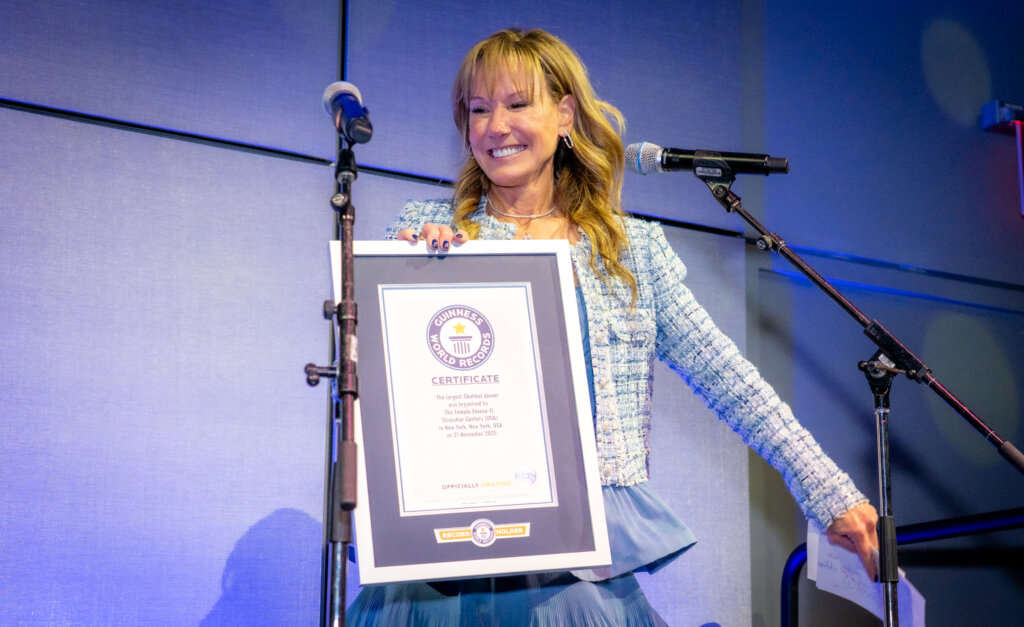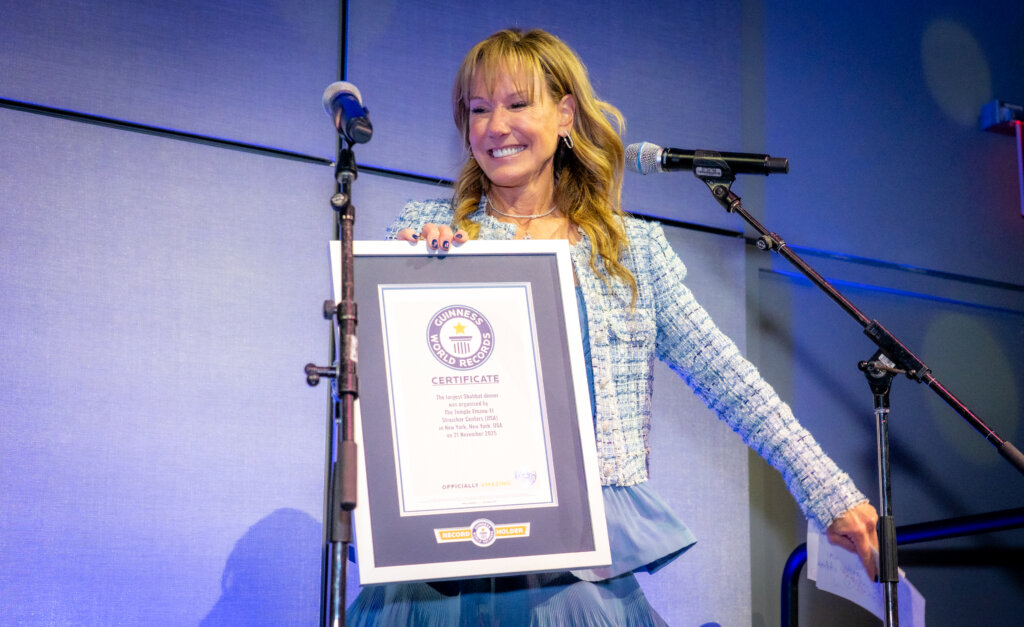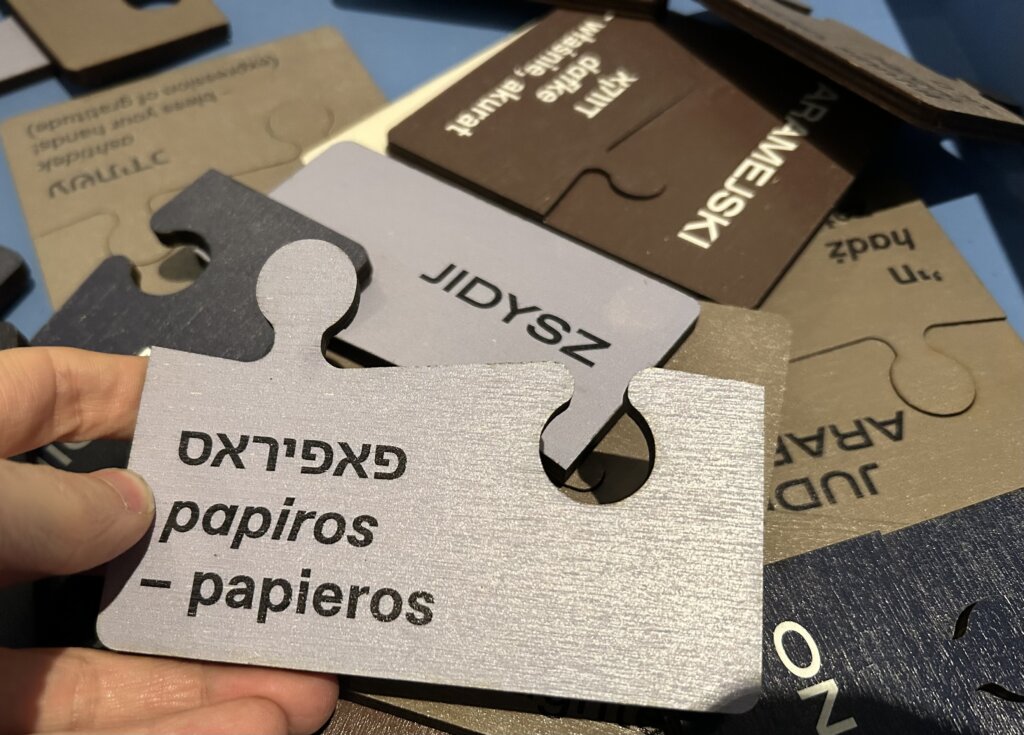Uncategorized
A Brazilian, Moroccan and Israeli singer brings her unique North African sound to NYC
(New York Jewish Week) — Though she grew up in Israel, Tamar Bloch’s childhood was a mishmash of cultures. With a Moroccan mother and Brazilian father, Bloch often heard Portuguese and Arabic alongside Hebrew, and felt connected with the music from all three cultures.
It wasn’t until she was in her early 20s, however, that Bloch discovered the language and culture of “Haketia,” a Romance language once spoken by Sephardic Jews in North Africa. Haketia has elements of Darija (Moroccan Arabic), Spanish and Ladino.
“I was hooked immediately,” Bloch, 33, told the New York Jewish Week. She could only find ethnographic recordings of Haketian songs at the Israel State Archives and at Hebrew University in Jerusalem, which she painstakingly transcribed and re-recorded herself — becoming the first modern artist to record an album in Haketia.
Over the last decade, Bloch — who goes by the stage name Lala Tamar; Lala is a Moroccan honorific meaning “Lady” or “Miss” — has traveled the world touring her music, working with bands and promoting the language and sound of Haketia.
This weekend, Bloch is traveling to New York from her home in Essouria, Morocco to perform several concerts at Lincoln Center for the Performing Arts. The New York Jewish Week caught up with her to talk about her performances in the United States and what Haketia means to her.
New York Jewish Week: How did you become aware of Haketía and then decide to pursue it in your music?
Bloch: I did not know it as a kid. I grew up with a mom who did speak Darija, which is Moroccan Arabic, which integrated and mixed inside Haketia, and with a dad who was born in Brazil, so there was Portuguese and a lot of Latin music in the house.
So I grew up with the basics of Haketia at home — the words and the Latin languages and the Arabic languages surrounding me. But I never really spoke it because they were speaking it with the older generations, with my grandparents and not with us, the kids.
When I grew up a bit I fell in love with Moroccan music. I happened to hear Haketia music. Immediately, I was hooked. For me, it was a very condensed cultural combination of my background, of the way I grew up. Not only literally, with the words and the language, but also musically because it has this combination of Spanish and Andalusian music and North African music. It’s all fused together in Haketia. I decided that I needed to investigate and to search for more of this music. These songs were never really recorded in an artistically contemporary way. If anything, they were recorded for the sake of preservation as a part of ethnographic research for universities. But it was not out there as music for everybody. I felt that this music deserves to be heard and to be served to everybody. It doesn’t have to be a part of a long forgotten tradition that’s lost in the archives.
What has been like the most meaningful part of the last decade of bringing Haketia back into the modern world and of touring your music around the globe?
I think that the biggest moment was when I got into the playlist of Galgalatz in Israel, which is one of the country’s most popular radio stations. One of the singles got into a playlist, and it was the first time that Haketia was played on contemporary, popular radio. That was really exciting. Also when we released our album. Even though it was in the middle of COVID, so it did not get any of the attention we were expecting for it, it was still exciting to to release an album in this in this lost language, and to hear people play it at parties and to have people sending me videos in restaurants. It’s always exciting to hear it.
I didn’t feel like I had a mission to make Haketia or this music more mainstream. It just happened because I felt that this music was relevant for me. I felt very much connected to it in a way that made me just release it as if there was nothing different about it, as if I would be singing anything else.
Why did you decide to move to Morocco from Israel during the pandemic?
I started performing in Morocco and realized that it’s always been the source of my inspiration, the fountain of my creation. At one of the festivals that I did there, I met Maalem (Master) Seddik, a Muslim musician that teaches Gnawa, a specific style of religious Moroccan music that I was fascinated by and, also, I was fascinated by the connection with the Jewish history in Morocco. I was waiting for the opportunity to go and study with him and then COVID struck and I had no job, of course.
Also, my inspiration and everything in my life that I create comes from Morocco. (During the 18th and 19th centuries, Jews made up nearly half of the population of Essouira — then called Mogador.) So when I was not singing I felt that my fountain was being dried out, so I already had this dream of going to study with him and I managed to find a way to get into Morocco which was really complicated at the time. He [Seddik] was waiting for me and welcomed me in. I started studying with him and he really adopted me, almost as a daughter, cooking for me, making me all these Jewish foods that he knows how to make from his neighbors and all his Jewish friends, and I just stayed. I have a lot of followers and an audience in Morocco as well as a lot of musicians that I work with so for me, it really felt like home from the beginning.
How does it feel to be performing in New York for the first time?
I have been doing online shows for Lincoln Center, but I’ve never performed physically in New York. It’s really exciting. I can’t describe how blissful we feel to come all this way. It’s a really big honor for my band’s first live performance in the United States to be at Lincoln Center.
I can only imagine how it will be because I don’t know. I can say I perform around the world, more than in Israel these past few years. I feel that this music has something that just can reach people from whatever background they come from. I hope that’s going to be the case as well, here in New York and New Yorkers are very open minded, very aware of what’s happening around the globe culturally.
Lala Tamar will perform a series of five concerts between May 5-7 at Lincoln Center for Performing Arts (113 West 60th St.). To find concert times and purchase tickets (choose-what-you-pay), visit their website.
—
The post A Brazilian, Moroccan and Israeli singer brings her unique North African sound to NYC appeared first on Jewish Telegraphic Agency.
Uncategorized
I attended a world-record breaking Shabbat dinner. You won’t believe how much we ate.

As my mother likes to remind me whenever I host, it’s better to err on the side of too much food than too little.
But 811 pounds of potatoes for kugel, 402 challahs, and 22,500 hors d’oeuvres? Even she might have called that a meshuggeneh idea.
Thankfully, this wasn’t Shabbat with my parents; this was at the Javits Convention Center in Manhattan where nearly 3,000 hungry Jews filed in, ready to eat their fill.
If the sheer volume of challah didn’t give it away, this was no ordinary homecooked meal — it was a bid to break the world record for the largest Shabbat ever held. The record had been held by Berlin, Germany, which hosted 2,322 participants at a Shabbat dinner in 2015.
Temple Emanu-El’s Streicker Center organized the event, supported by a $500,000 grant from UJA-Federation of New York. Tickets cost $54 apiece, and the waitlist had to be capped at 1,200.
Upon entering the high-security venue, guests were greeted by food carts distributing Jerusalem bagels — oval-shaped, sesame-dusted delights. One man, already sizing up the abundant spread, tried to pawn an uneaten portion of his bagel off on me. “I can’t eat it all!” he said.
Attendees tucked notes into a miniature replica of the Western Wall; the notes would later be sent to the real thing in Jerusalem. Hors d’oeuvres consisted of mini potato knishes, baked phyllo feta sticks, and lox atop cucumber slices (presumably nova, but this reporter could not verify). Guests sipped ga’zoz, a popular Israeli soda.
When it was time to be seated, each guest was assigned a table number within a color-coded section. We were told there was only one rule that the Guinness adjudicator, a Brooklyn Jew named Andrew Glass, would be verifying: Attendees must remain seated for an hour.
No bathroom breaks? No time to stretch? This would be harder than I thought.
Luckily, the hosts provided ample entertainment to keep our tucheses firmly planted. The program began with an AI-generated video of Abraham the Hebrew patriarch, Albert Einstein, Ruth Bader Ginsberg, and Golda Meir, up in heaven, offering commentary about the Big Shabbat.
“Golda, did you make enough food?” AI-generated-Ginsburg asked.
Next came the live celebrity appearances: Actor Jonah Platt sang “Shalom Aleichem,” the poem commonly sung at the beginning of a Shabbat meal, and Broadway stars Steven Skybell and Shoshana Bean performed “Sabbath Prayer” from Fiddler on the Roof.
Former Hamas-held hostage Omri Miran and his wife, Lishay, led the candle lighting. Bestselling cookbook authors Adeena Sussman, Jake Cohen, and Joan Nathan led the kiddush and Hamotzi.
After the prayers, we sampled Israeli pickles and olives, hummus, za’atar-spiced pita, mini potato kugels, and Keye Sir, an Ethiopian beet salad by Chef Beejhy Barhany. For those who still had room, the main course followed, featuring chopped salad, tomato-jam roasted salmon, and vegan lasagna.

Then came the night’s pièce de résistance: A woman in a sparkling leotard, suspended by wires from the ceiling, performed a soaring, midair rendition of “If I Were a Rich Man” on the violin.
As the hour drew to a close, Glass noted that an on-site food safety specialist had confirmed all dishes were safe to eat, and a rabbi had verified that everything was kosher. Most importantly, we had been instructed to remain seated the entire time for counting purposes.
“Unfortunately, there were a few deductions from the count,” he said, drawing boos from the crowd.
Had all this fressen been for nought?
“You achieved 2,761,” he said. “Congratulations!”
The Jewish a cappella group Six13 erupted into singing “We Are the Champions.” We were officially world record holders.
Now, it was time for dessert.
The post I attended a world-record breaking Shabbat dinner. You won’t believe how much we ate. appeared first on The Forward.
Uncategorized
An exhibit at Warsaw’s Polin Museum on the history of Jewish languages

אין אַ נײַער אויסשטעלונג בײַם ייִדישן מוזיי „פּולין“ זעט מען, אַז עספּעראַנטאָ איז אויך אַ ייִדישע שפּראַך.
די סיבה דערפֿאַר איז נישט בלויז ווײַל דער פֿאַרטראַכטער פֿון עספּעראַנטאָ, ד״ר לייזער זאַמענהאָף, איז געווען אַ ייִד, אַ געבוירענער אין ביאַליסטאָק. אין די ערשטע יאָרן זענען אַ סך רעדערס פֿון עספּעראַנטאָ געווען ייִדן, ווײַל זיי האָבן געליטן פֿון אַנטיסעמיטיזם און האָבן געחלומט פֿון אַ וועלט אָן נאַציאָנאַלע און רעליגיעזע גרענעצן. דער ייִדישיסט און עספּעראַנטיסט, ד״ר צבֿי סדן, האָט טאַקע אַ מאָל באַמערקט: „עספּעראַנטאָ איז ייִדיש פֿאַר גויים“.
פֿון דעסט וועגן, איז די צענטראַלע שפּראַך בײַ ייִדן אין משך פֿון דער גאַנצער געשיכטע אַוודאי העברעיִש, און דער פֿאַקט ווערט נישט פֿאַרשוויגן אין דער נײַער אויסשטעלונג. זי הייבט זיך אָן מיטן אַלטן העברעיִש אין די אויפֿשריפֿטן אין „כּתבֿ עבֿרי“, די אַלטע אותיות, וואָס ייִדן האָבן געניצט אין דער צײַט פֿון די מלכים, פֿאַרן גלות בבֿל.
דערנאָך האָבן זיי אָנגעהויבן אַריבערגיין צום „כּתבֿ אַשורית“, די אַסירישע אותיות — דאָס וואָס מיר רופֿן הײַנט „העברעיִשע אותיות“. די אויסשטעלונג לאָזט זיך אויס מיטן מאָדערנעם העברעיִש, עבֿריתּ, וואָס דער ליטוואַק אליעזר יצחק פּערלמאַן האָט געהאָלפֿן צו באַנײַען און אויפֿצולעבן סוף 19טן י״ה. יענער פּערלמאַן איז אונדז באַקאַנט מיטן נאָמען אליעזר בן־יהודה.
אין משך פֿון אַן ערך 2,500 יאָר צווישן דער תּקופֿה פֿונעם „כּתבֿ עבֿרי“ און דעם הײַנטיקן עבֿריתּ האָבן זיך ייִדן באַניצט מיט אַ סך אַנדערע שפּראַכן — אַזוי פֿיל, אַז מע קען זיי אַפֿילו נישט אויפֿציילן. עטלעכע קען מען באַטראַכטן ווי אמתע ייִדישע שפּראַכן, ד״ה אַזעלכע, וואָס ייִדן האָבן זיי פֿאַרהיימישט און פֿאַרייִדישט, אַפֿילו ווען זיי זענען לכתּחילה געווען וואַריאַנטן פֿון גוייִשע שפּראַכן.
די ערשטע שפּראַך אַזאַ איז געווען אַראַמיש, וואָס אויף איר זענען געשריבן גרויסע טיילן פֿון ספֿר דניאל און ספֿר עזרה, ,ווי אויך דער גרעסטער טייל פֿונעם תּלמוד. כאָטש מיר רופֿן די שפּראַך פּשוט „אַראַמיש“, איז זי באמת ייִדיש־אַראַמיש, ווײַל אַ סך אַנדערע פֿעלקער האָבן אויך גערעדט פֿאַרשידענע סאָרטן אַראַמיש — גוייִש־אַראַמיש — ביזן הײַנטיקן טאָג.
דאָס דריטע רינגל אין דער קייט פֿון ייִדישע לשונות איז ייִדיש־גריכיש, וואָס איז אויפֿגעקומען נאָך דעם ווי אַלכּסנדר מוקדון האָט אײַנגענומען די ריזיקע פּערסישע אימפּעריע, אַרײַנגערעכנט ארץ־ישׂראל. אַ סך ייִדן זענען געווען צוגעצויגן צו דער גריכישער שפּראַך און קולטור, ווי מיר ווייסן פֿונעם יום־טובֿ חנוכּה. פֿאַרשידענע סאָרטן ייִדיש־גריכיש האָט מען גערעדט אין משך פֿון איבער צוויי טויזנט יאָר, ביז נישט לאַנג צוריק. ליידער האָבן די נאַציס און זייערע מיטהעלפֿערס אויסגעהרגעט אַ סך פֿון די לעצטע רעדערס פֿון ייִדיש־גריכיש, וואָס מע רופֿט זיי די ראָמאַניאָטעס. די פֿאַרבליבענע ראָמאַניאָטישע ייִשובֿים אין גריכנלאַנד רעדן הײַנט שוין דאָס גוייִשע גריכיש, ווי זייערע שכנים.
ווען די רוימער האָבן אײַנגענומען אַלע לענדער אַרום דעם מיטלענדישן ים, האָבן די ייִדן אויך אָנגעהויבן רעדן לאַטײַן, לכל־הפּחות אין דער מערבֿדיקער העלפֿט פֿון דער אימפּעריע. (אין מיזרח האָט מען ווײַטער גערעדט גריכיש.) לאַטײַן האָט זיך מיט דער צײַט פֿאַרוואַנדלט אין די הײַנטיקע ראָמאַנישע שפּראַכן: איטאַליעניש, שפּאַניש, פֿראַצויזיש אאַז״וו.
יעדע ראָמאַנישע שפּראַך האָט געהאַט אַ ייִדישן וואַריאַנט. נאָכן גירוש ספֿרד למשל האָבן אַ סך שפּאַנישע ייִדן זיך באַזעצט אין דער אָטאָמאַנישער אימפּעריע, האָט זייער ייִדיש־שפּאַניש (וואָס מע רופֿט הײַנט לאַדינאָ) אַרײַנגענומען אַ סך ווערטער פֿון די אָרטיקע לשונות: פֿון טערקיש, אַראַביש, אויך פֿון די באַלקאַנישע שפּראַכן.
די אויסשטעלונג דערציילט נישט צו פֿיל וועגן דער געשיכטע פֿון ייִדיש, אָבער אינעם קאָנטעקסט פֿונעם גאַנצן „פּולין“־מוזיי איז דאָס נישט קיין עוולה. די פּערמאַנענטע אויסשטעלונג האָט זייער אַ סך וועגן ייִדיש און וועגן דער קולטור אויף ייִדיש. עטלעכע אַמעריקאַנער פֿאָרשערס, גוטע ייִדיש־קענערס, אַזוי ווי ברײַנדל קירשנבלאַט־גימבלעט און שמואל קאַסאָוו, האָבן געדינט דעם מוזיי ווי עצה־געבערס, און אפֿשר דערפֿאַר איז דאָ אַ סך מער ייִדיש אין „פּולין“־מוזיי ווי אין אַנדערע ייִדישע מוזייען אויף דער וועלט. (הלוואַי וואָלט געווען אַזאַ מוזיי אין ניו־יאָרק אָדער תּל־אָבֿיבֿ!)

אָבער די קוראַטאָרן פֿון דער אויסשטעלונג האָבן געהאַט אַ פּראָבלעם: דער דורכשניטלעכער פּוילישער באַזוכער קען נישט לייענען די העברעיִשע אותיות. אַפֿילו די ייִדישע באַזוכער און די געסט פֿון אויסלאַנד זענען מסתּמא קנאַפּע קענערס פֿון ייִדיש־גריכיש און ייִדיש־פּערסיש, למשל. איז נישט קיין חידוש, וואָס מע האָט דאָ געלייגט דעם טראָפּ אויף די שיינע עקספּאָנאַטן און נישט אויף די שפּראַכן גופֿא. מע ווײַזט אַ סך אַלטע חפֿצים, ספֿרי־תּורות, כּתבֿ־ידן, קמיות, פּרעכטיקע אילומינאַציעס. אפֿילו קינדערלעך, וואָס קענען נישט קיין צורת־אות, קענען הנאה האָבן פֿון אַזאַ שיינקייט.
דער אינטערעסאַנטסטער טייל פֿון דער אויסשטעלונג איז, לויט מיר, ווען מע קען הערן עטלעכע פֿון די ייִדישע שפּראַכן. מע האָט הײַנט זעלטן אַ געלעגנהייט צו הערן ייִדיש־גריכיש אָדער ייִדיש־איטאַליעניש, אָדער אַפֿילו לאַדינאָ. ס׳איז טשיקאַווע צו הערן, ווי די שפּראַך קלינגט, און צו פּרובירן אַ ביסל צו פֿאַרשטיין. אַ סך פּוילישע סטודענטן פֿון ייִדיש וועלן דערקענען דאָס קול, וואָס רעדט דאָרט ייִדיש, ווײַל עס איז עטל ניבאָרסקי, וואָס איז עטלעכע מאָל געקומען קיין פּוילן, כּדי צו לערנען אין דער וואַרשעווער זומער־פּראָגראַם. נאָך בעסער וואָלט געווען, ווען מע ווײַזט אויפֿן עקראַן דעם טעקסט פֿון די ווערטער וואָס מע רעדט, ווײַל אַזוי וואָלט מען געקענט פֿאַרשטיין אַ ביסל בעסער.
אויך זייער געראָטן זענען די שפּילערײַען אין דער אויסשטעלונג, וואָס זענען נישט בלויז פֿאַר קינדער. עס זענען דאָ שטיקלעך פֿון אַ רעטעניש (פּאָזל) מיט פֿאַרשידענע ווערטער, וואָס מע דאַרף זיי צונויפֿפּאָרן מיט אַנדערע שטיקלעך מיטן נאָמען פֿון דער שפּראַך. מע קען דאָרט אַנטדעקן, למשל, אַז דאָס וואָרט „פּופּיק“ קומט פֿון טשעכיש, און אַז דאָס וואָרט „דברארה“ (dabberare) מיינט „רעדן“ אויף ייִדיש־איטאַליעניש.

די אויסשטעלונג איז דער עיקר אַ קינסטלערישע און אַ היסטאָרישע, נישט קיין לינגוויסטישע. פֿון דעסט וועגן, פֿעלט דאָרט אַ ביסל דער הײַנטיקער מצבֿ. מיר ווייסן דאָך, אַז הײַנט רעדט מען נישט קיין ייִדיש־איטאַליעניש אָדער ייִדיש־גריכיש און אַ סך פֿון די אַנדערע אַמאָליקע ייִדישע שפּראַכן. אונדזער ייִדיש האָט דווקא גרויס מזל, וואָס די חסידים האָבן זיך אָנגעכאַפּט אין איר און רעדן זי מיט זייערע קינדער. אַנדערש וואָלט דער מצבֿ טאַקע געווען ביטער.
אָבער הײַנט רעדן ייִדן, דער עיקר, עבֿריתּ, אויב זיי וווינען אין מדינת־ישׂראל, אָדער ענגליש, אויב זיי וווינען אין די תּפֿוצות. עטלעכע הונדערט טויזנט רעדן פֿראַנצויזיש, רוסיש און שפּאַניש. דאָס הייסט, דווקא די שפּראַכן, וואָס ייִדן רעדן הײַנט פֿעלן אין דער אויסשטעלונג.
ס’איז אמת, אַז ייִדיש־ענגליש און ייִדיש־שפּאַניש, למשל, זענען באמת נישט קיין שפּראַכן פֿאַר זיך. מיט אַנדערע ווערטער, אַז מע וווינט אין אַ ייִדישער סבֿיבֿה, קען מען אַרײַנוואַרפֿן ווערטער און קאָנסטרוקציעס פֿון העברעיִש אָדער ייִדיש. די פֿאָרשערין פֿון ייִדישע שפּראַכן, שׂרה בענאָר, רופֿט דאָס אַ ייִדישער „רעפּערטואַר“, וואָס ייִדן קענען ניצן, ווען זיי ווילן.
אַז אַ ייִד זאָגט למשל: Good Shabbos! The seudah will be by me. See you in shul קען מען בולט זען די השפּעה פֿון ייִדיש דאָ און מע פֿאַרשטייט דעם באַגריף „ייִדישע שפּראַך“ נישט בלויז טעאָרעטיש, נאָר מע זעט באַשײַמפּערלעך, ווי אַזוי מע מישט אַרײַן די העברעיִשע און ייִדישע ווערטער. דער זעלבער פּרינציפּ איז געווען אין כּמעט אַלע ייִדישע שפּראַכן, אויך אין ייִדיש — בלויז אַ סך מער אַנטוויקלט. דערפֿאַר וואָלט ייִדיש־ענגליש געהאַט אַ גרויסע מעלה פֿאַר אַזאַ אויסשטעלונג, ווײַל די מערסטע באַזוכערס קענען דאָס פֿאַרשטיין.
די אויפֿלעבונג פֿון העברעיִש דורך די ציוניסטן פֿאַרדינט אויך מער פּלאַץ אין אַזאַ אויסשטעלונג. די געשיכטע דערציילט מען יאָ: מע זעט בן־יהודה מיט זײַן ווײַב, חמדה, מיט זײַן ווערטערבוך. פֿון דעסט וועגן, פֿאַרדינט די געשיכטע אַ ביסל מער חשיבֿות. די אויפֿלעבונג פֿון אַ טויטער שפּראַך — אָדער פֿון אַ שפּראַך וואָס מע רעדט שוין נישט — איז גאָר אַ זעלטענער אויפֿטו. דערווײַל האָט מען אויפֿגעלעבט אויך אַנדערע שפּראַכן, וואָס זענען געווען טויט אָדער אין אַ סכּנה פֿון אונטערגיין (למשל, האַוואַיִש און מאַאָרי) — אָבער קיין מאָל נישט מיט דער הצלחה ווי די ציוניסטן האָבן באַוויזן מיט העברעיִש. עבֿריתּ איז באמת אַ מין נס אין דער געשיכטע פֿון דער מענטשהייט, נישט נאָר פֿון די ייִדן. אַוודאי זענען פֿאַראַן גענוג ייִדן, וואָס האַלטן נישט פֿון עבֿריתּ, אַ מאָל צוליב לעגיטימע פּאָליטישע אָדער רעליגיעזע סיבות (אַ טייל חרדישע ייִדן, למשל.) אָבער אין אַן אויסשטעלונג וועגן ייִדישע שפּראַכן פֿאַרדינט זי אַ גרעסער אָרט.
The post An exhibit at Warsaw’s Polin Museum on the history of Jewish languages appeared first on The Forward.
Uncategorized
NYPD commissioner Jessica Tisch apologizes for allowing ‘turmoil’ outside synagogue
(JTA) — Days after pro-Palestinian protesters shouted chants including “Globalize the Intifada” and “Death to the IDF” outside an Upper East Side synagogue, NYPD Commissioner Jessica Tisch, who is Jewish, apologized to the congregation during Shabbat services.
Tisch told congregants it was the police department’s duty “to ensure that people could easily enter and leave shul.”
“That is where we fell short,” Tisch said, according to reports from the service. “And for that, I apologize to this congregation.”
The apology from Tisch, who said police allowed “turmoil” to take place outside a synagogue on Wednesday night, was far apart in its tone from the statement issued by Mayor-elect Zohran Mamdani’s team, which “discouraged” the language at the protest, while suggesting that the event was a misuse of a “sacred space.”
The protest occurred outside Park East Synagogue, a prominent Orthodox congregation, while it hosted an event promoting migration to Israel. The protest drew allegations of antisemitism from Jewish leaders and major Jewish organizations, as well as elected officials like Gov. Kathy Hochul and Mayor Eric Adams.
But some also criticized the police response, saying they allowed the confrontation to unfold.
“What I find most disturbing is that the police, who knew about this protest a day in advance, did not arrange for the protesters to be moved to either Third or Lexington Avenues,” said Rabbi Marc Schneier, whose father is the longtime senior rabbi at Park East Synagogue, the day after the protest. “Instead, they allowed the protesters to be right in front of the synagogue, which put members of the community at risk.”
Tisch acknowledged on Saturday that police should have set up a “frozen zone” at the synagogue’s entrance; because one was not set up, she said, “the space right outside your steps was chaotic.” Pens with barricades were set up for both the pro-Palestinian protesters and pro-Israel counter-protesters, though the former group “headed for the building entrance before ultimately pulling back to their pen,” a police source told the New York Daily News.
Tisch said that the protesters were protected by a First Amendment right to protest, even near a house of worship, and said “the NYPD must uphold that right.”
“They have the right to say things that are incredibly painful to hear. I understand that pain, deeply and personally,” Tisch said.
But, Tisch continued, police could have done more to shield attendees of the event.
“You deserved an NYPD posture that recognized the sensitivity of this location, the climate we’re living in, and the heightened fear within our community,” she said. “Instead, you had turmoil.”
At the conclusion of her remarks, Tisch was reportedly met with a standing ovation, as well as kudos from New England Patriots owner Robert Kraft, who was in attendance. Kraft is the founder of the Blue Square Alliance against Hate, formerly called the Foundation to Combat Antisemitism.
While Tisch conceded the police could have done more, the congregation’s senior rabbi, Arthur Schneier, who is a Holocaust survivor, told the New York Post that he was grateful for the presence of the NYPD.
“Thank God in the United States, the police are protecting us against the hate-mongers,” Schneier said, contrasting their presence to the police’s cooperation during Kristallnacht.
Tisch’s appearance at Park East came less than a week after she accepted the offer from Mamdani to stay on as police commissioner, which some Jewish leaders viewed as a reassuring sign at a time when anti-Jewish hate crimes are rising. The move to keep Tisch also drew praise from Donald Trump when he met Mamdani at the White House on Friday.
But while Tisch drew the congregation’s applause with her apology, her future boss’ response to the protest was criticized by a number of Jewish leaders and organizations.
“The Mayor-elect has discouraged the language used at last night’s protest and will continue to do so,” Mamdani’s press secretary said in a statement.
She went on, “He believes every New Yorker should be free to enter a house of worship without intimidation, and that these sacred spaces should not be used to promote activities in violation of international law.”
Following the response from Mamdani’s team, UJA-Federation of New York sent a statement reading that “Every leader must denounce this heinous language,” while Mark Treyger, CEO of the Jewish Community Relations Council, said that it is “not a violation of any law, international or otherwise, for Jews to gather in a synagogue or immigrate to Israel.”
The event at Park East was organized by Nefesh B’Nefesh, a nonprofit that facilitates immigration to Israel for North American Jews. It does not assign immigrants to particular communities, but has showcased West Bank settlements — which most of the world, though not Israel or the United States, considers illegal under international law — in events and on its website as possible destinations for new immigrants.
Tisch’s current boss, Adams, visited Park East Synagogue Monday morning where he met with Arthur Schneier.
“We don’t back down in the face of hate — we show up,” wrote Adams, who returned on Sunday from a trip to Israel and Uzbekistan.
The post NYPD commissioner Jessica Tisch apologizes for allowing ‘turmoil’ outside synagogue appeared first on The Forward.


